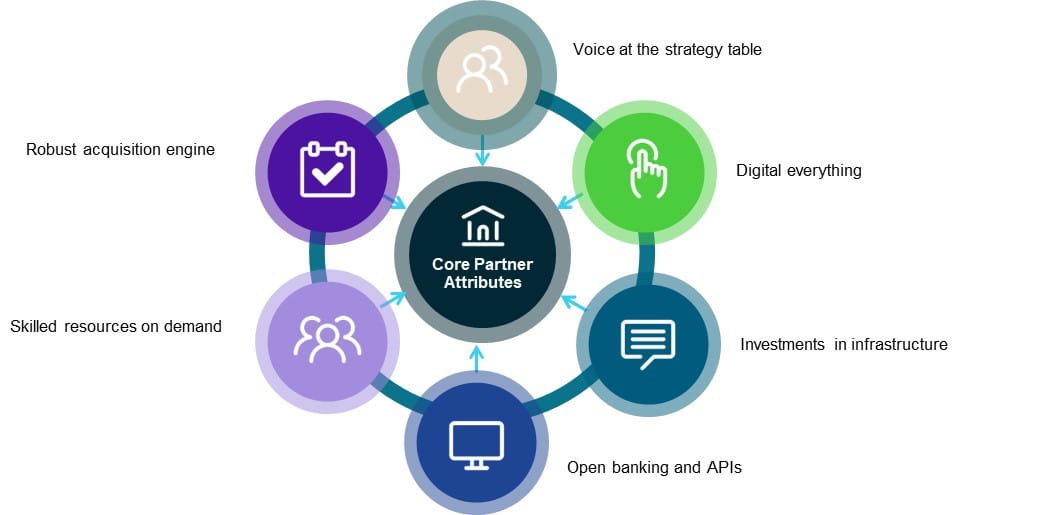Banking Leader
What Bankers Should Expect from Their Core Technology Partner
Mike Gravelle | VP Product Management, North America Banking Solutions, FIS
December 03, 2019
Financial institutions’ fortunes can rise, or fall, based on the quality of the technology partnerships they cultivate. Given their investment in core banking platforms, these providers form the primary partnership and most integral ally for U.S. banks. Bankers must expect more from core banking partners, both in terms of technology innovation and system performance, but also in services that can fill critical needs as market demands emerge.

The following six capabilities are a baseline for bankers looking to thrive based on strong core technology partnerships:
Consumers expect the latest digital capabilities and are often more interested in what features a provider delivers than the core provider itself. Financial institutions are challenged to offer a consistent and frictionless experience across all interactions with their customers. Your core partner needs to continuously make significant digital technology investments that deliver a modern omnichannel digital solution tightly integrated with your core platform.
Your bank must keep pace with increasing demands for an always-on, streamlined user experience. You should expect a component-based digital offering that provides consistent engagement between bankers and your customers, across all channels. A component-based architecture should future-proof your core banking platform while ensuring the benefits from ongoing developments in cloud computing capabilities.
Investment in core technology infrastructure
Foundational investments by your core banking provider can combine to yield important bank benefits. Expect investments from your core partner in:
Converged infrastructureConverged infrastructure is a computing infrastructure that includes two or more computing solutions combined and delivered through collaboration as a unified solution. Converged infrastructure uses a pre-configured computing solution designed to provide centralized management of IT resources.
Data center modernizationData center upgrades should trigger the modernization and standardization of the underlying technology stacks within the provider’s facilities. The guiding principle of modernization efforts is to drive standardization and simplification of the core technology stack to enable high availability and speed-of-service delivery.
Database optimization and restructuringIn practice, any database management system sometimes needs reorganization, that is, a change in some aspect of the logical and/or physical arrangement of a database. Sound IT management by your core provider should support reorganization and performance tune-ups for the databases supporting complex financial ecosystems.
Voice at the strategy table
Besides a robust technology foundation, partnerships thrive on open, two-way feedback to make the bank/provider relationship pay off. Your core provider should have regular forums that encourage open dialog on key industry trends to ensure market relevance and ongoing competitiveness for bank technology solutions.
Forum participants should assist the core provider in prioritizing technology investment strategies in the areas of solution capabilities, infrastructure and professional services. Strategic discussion should center around a timeline of 18-36 months. Other forums will be more tactical in nature, with a more immediate outlook for product development. Banks participating should represent the voice of the client base, offering direction and assistance in ensuring a core provider’s product and service offerings continue to meet user and market needs.
Open banking and APIs
Today’s market requires an open-banking framework that allows financial institutions to quickly innovate while preserving extensive investments in traditional systems and ensuring regulatory soundness. Your core partner should have a library of APIs easily found and organized for rapid consumption. For example, FIS has invested in the award-winning API platform, FIS Code Connect, which was recognized as “the most advanced API platform and environment of the leading U.S. core providers” by Aite Group in 2019. Code Connect provides a modern API framework that enables access and execution of all functional capabilities inherent within the core banking suite. Today’s open banking investment should focus on a digital-first experience that is analytics-driven, cloud-capable and API-powered. Real-time notifications and data that deliver enhanced alerting, fraud detection and proactive data synchronization should be expected from your partner.
A robust acquisition engine
Growth in bank merger and acquisition (M&A) activity places pressure on surviving banks to perform while trying to consolidate acquired institutions. Banks need to excel when acquisition opportunity knocks. Banks with strong partnerships can leverage the conversion methodology, proven tools and experience of their core partner provider. Banks processing on a service bureau can leverage a standardized approach their partner has developed for converting many new entities to one platform. High-level steps in such an approach include:
- Developing a program plan
- Creating a Target Operating Model (TOM) based on a comprehensive solution design
- Developing a test strategy and test plan
- Optimizing business processes of the new entity
- • Executing an M&A playbook
Skilled resources on demand
Staff augmentation allows organizations to acquire the benefits of advisory process, product, technology and project management expertise to support bank-critical activities. There are times when a bank’s permanent staff benefits from subject experts familiar with both banking processes and banking technology. A close partnership with your core vendor enables human resources with specific skill sets to help solve problems or take advantage of market opportunities. These resources act as an extension of your staff on an as-needed basis, helping your team:
- Grow your staff knowledge with the precise skill sets while addressing temporary resource needs.
- Provide governance at the project and program levels.
- Develop quality management strategies and test plans.